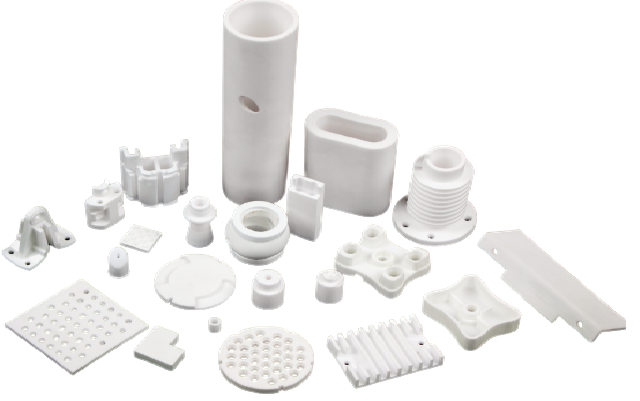Everything You Need To Know About Alumina Ceramics

Alumina ceramics, ceramics made up of primarily aluminum and oxygen, are
considered advanced ceramic materials. Numerous manufacturers favor aluminum
oxide ceramics because of their high thermal conductivity, insulation capability
resistant to corrosion, and extreme hardness. For these reasons, they are used
in a variety of manufacturing techniques.
We'll discuss the properties, production, and use of ceramic parts and all other
pertinent information about the alumina ceramic material. Let's dive in
already!
What is Alumina Ceramics?
Alumina ceramic (also known as aluminum oxide (Al2O3)) is an industrial-grade
ceramic with excellent thermal conductivity and extremely hardness. The
properties of alumina ceramics make them among the most frequently employed
ceramics in construction, wear and corrosive conditions.
Alumina ceramics are usually made by bauxite. They are formed by injection
molding, die pressing, isostatic pressing, slip casting, diamond machining and
extrusion. Alumina, along with aluminum nitride and other essential engineering
materials can be created by either dry pressing and the sintering process or hot
pressing using appropriate sintering aids.
Alumina-based ceramics are among the most studied and characterized advanced
ceramic materials that are currently in use. The behavior of these ceramics has
been extensively studied due to their unique combination of properties. Alumina
has a high degree of hardness and excellent resistance to corrosion thermal
stability, excellent dielectric properties (for conversion from DC to GHz
frequencies), low losstangent and stiffness. For more information on the
properties and uses of alumina ceramic materials, please refer to the next
section.
Properties of Alumina Ceramics
Based on the percentage of Al2O3 and the additives that are used There are
various series of aluminum oxide Mateials.
According to the Al2O3 content, alumina can be categorized as 75% alumina 85
% alumina, 95% alumina, 99.99 alumina, and so on.
Based on the distinction in crystal phase, there are mullite,
corundum-mullite, and corundum;
The variety of additives used can be classified as titanium Corundum,
chromium Corundum, and others.
Alumina is a great electrical insulation that can withstand extremely high
currents. The resistance to electricity also increases with purity. The more
pure alumina is and the more resistant it will be.
Alumina is also believed for its high melting point and a high mechanical
strength. However, its mechanical strength decreases as the temperature is
higher than 1000 ° Celsius. Due to the significant difference in its coefficient
thermal expansion, it is less resistant to shocks when exposed to very high
temperatures.
The outstanding chemical stability of alumina is the main contributor to its
high resistance to corrosion.
Alumina can also dissolve in some strong acids (such as hot sulfuric, hot HCl
or the HF). Alumina dissolves in alkaline and acidic solutions, but not in
water. Pure alumina can resist chemical corrosion, making pure alumina the most
preferred choice for engineering components in several industrial applications.
The resistance to corrosion caused by chemicals has been proved to be due to its
low solubility in those chemicals.
Additives are used to improve the physical and chemical properties of the
alumina. These additives, combined with different manufacturing processes will
aid in the production of alumina ceramics in varying sizes and shapes.
Ceramic materials made from Alumina are the most decomposable and have the
lowest vapor pressures.
As you are aware that alumina ceramics are comparable to aluminum nitride
because of their good thermal conductivity and excellent electrical insulation
properties.
Alumina Ceramics
Alumina ceramics are extensively used in acid-resistant pumps impellers,
valves, bodies and acid-carrying pipe liners due to their chemical
stability.
Ceramics made of aluminum oxide are used in the manufacture of textile wear
parts as well as knives. They are extremely tough and wear resistant.
Alumina ceramics are utilized for making spark plugs which are beneficial for
a myriad of engines.
Ceramics that are transparent can be used to make high-pressure sodium lamps
or infrared detection windows material.
With an alumina content higher than 95%, alumina-based ceramics can be used
as excellent electrical insulators. Ceramics made of alumina also have a low
loss dielectric, making them perfect for use in electronic and electrical
appliances.
Transparent aluminum oxide has good permeability to infrared and visible
light.
Other applications for ceramic balls are in seal rings, medical prostheses,
laser tubes, thermocouple tubes, electronic substrates ballistic armor,
electrical insulators grinding media, and wear parts.
Conclusion
Alumina ceramics are composed of aluminum oxide. The high thermal conductivity, high resistance to heat, the excellent electrical insulation properties and the superior resistance to chemical corrosion of Alumium Oxide mateials are a few reasons why they are a choice material for many industrial processes.
Comments
Post a Comment